Begin with an 8 to 12-minute warm-up, including shoulder stretches and upper body rotations to guarantee injuries are prevented. For chest strength, do Barbell Bench Press and Push-Ups. To target your back and biceps, incorporate Bent-Over Rows and Pull-Ups. Strengthen shoulders and triceps with Overhead Press, Triceps Kickbacks, and Face Pulls. Balance your workout with Dips and Farmers Carries for overall stability and upper body power. Make sure correct form is maintained to maximize benefits and avoid injuries. Keep progressing with variations and tracking for improvement. By following these exercises, you'll grasp essential techniques and advanced tips to enhance your upper body strength.
Key Takeaways
- Barbell Bench Press: Essential for building chest, shoulder, and triceps strength with proper form and variations.
- Push-Ups: Versatile exercise targeting chest, shoulders, triceps, and core with numerous variations for progression.
- Overhead Press: Develops shoulder, triceps, and core strength, enhancing overall upper body stability.
- Dips: Effective for upper body strength, focusing on triceps, chest, and shoulders with form and weight adjustments.
- Pull-Ups: Strengthens back, biceps, and forearms, improving grip strength and upper body muscle definition.
Warm-Up Stretches
Before delving into your upper body workout, it's crucial to spend 8 to 12 minutes on warm-up stretches to boost blood flow and prevent injuries. Think of it as giving your muscles a wake-up call so they don't hit snooze and leave you with a strained shoulder.
Start with some shoulder stretches to loosen things up. Next, try upper body rotations—twist like you're dodging awkward conversations at a party. Don't forget wrist flexing; your wrists need love too. These warm-up exercises increase your flexibility and prepare your muscles for action.
Jumping jacks are also great to get your heart rate up. By the end, you'll feel like a well-oiled machine, ready to tackle that workout without a hitch.
Barbell Bench Press
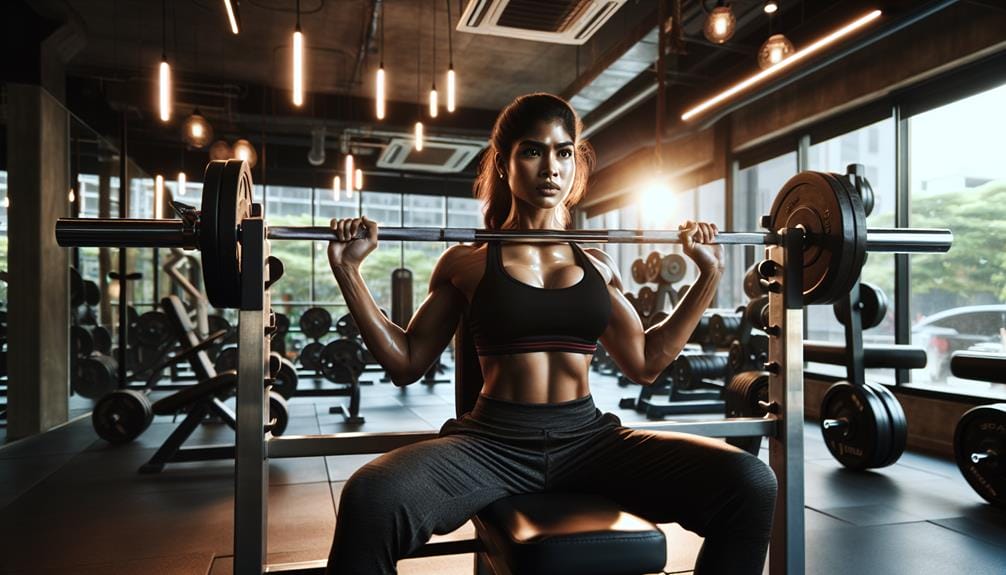
Now that you're warmed up, let's move on to the barbell bench press, a powerhouse exercise that targets your chest, shoulders, and triceps.
This compound movement is like the Swiss Army knife of upper body workouts, allowing you to lift heavier weights and build serious muscle. Make sure you use proper form—keep a stable grip, and control your descent and ascent. Imagine you're lowering fine china, not a barbell.
Variations like incline or decline bench presses can spice things up and hit different areas of your chest and shoulders. Remember, progressively overloading with more weight or reps keeps those gains coming.
Push-Ups
Push-ups are a fundamental exercise in any upper body workout plan. They target your chest, shoulders, triceps, and core muscles. To maximize their effectiveness, make sure you maintain proper form. This includes a straight body line, hands shoulder-width apart, and elbows tucked close to your body.
You can challenge yourself further with variations like incline, decline, and diamond push-ups. These variations target different muscle groups and increase the level of difficulty.
Proper Push-Up Form
Maintaining a straight line from your head to your heels during push-ups guarantees that your core muscles are engaged effectively. This isn't just for show; it's key to good form.
Imagine your body as a plank—sturdy and straight. Focus on lowering your chest to elbow level. That's right, get cozy with the floor.
Keep your hands shoulder-width apart, directly under your shoulders. Push through your palms, and keep those elbows close to your body. This targets your triceps and shoulders like a champ.
Not only will you feel your chest working, but your core will thank you too. Remember, good form isn't optional; it's essential.
Variations for Progression
Once you've mastered proper push-up form, exploring different variations can take your workout to the next level.
Ready to feel the burn? Try diamond push-ups to target your triceps, or wide grip push-ups to focus on your chest.
Elevate your feet for decline push-ups, challenging your upper body strength and endurance. These variations don't just make you look like a gym ninja; they stimulate muscle growth too.
Track your progress by counting reps or sets, aiming to beat your previous records.
Bent-Over Row
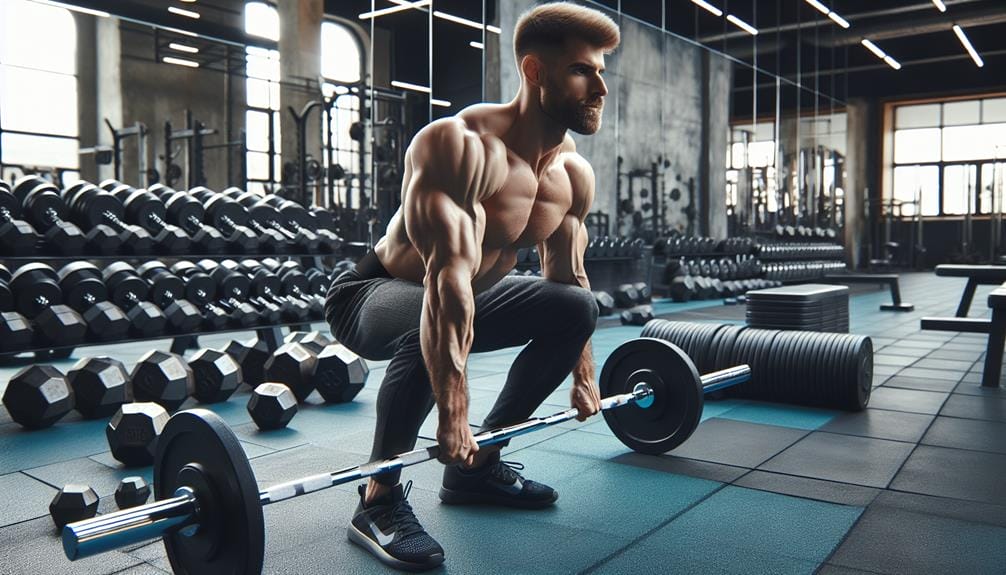
When performing the Bent-Over Row, you'll want to focus on proper form, which includes hinging at the hips and keeping your back straight.
Avoid common mistakes like rounding your back or using momentum to lift the weights.
This exercise not only strengthens your upper back, lats, and biceps but also offers variations with dumbbells or barbells to keep your routine dynamic.
Proper Form Essentials
For a safe and effective Bent-Over Row, make sure you keep your back flat and engage your core to prevent any strain on your lower back. As you begin these upper body exercises, proper form is your best friend. Keep your chest up and shoulders back, ensuring you're targeting those back muscles effectively.
Use an overhand grip slightly wider than shoulder-width; this engages your back muscles without contorting your wrists. Pull the weights towards your lower rib cage, focusing on squeezing your shoulder blades together – think of it as embracing your back. Lower the weights in a controlled manner to maximize the workout.
Common Mistakes Avoided
Many people make common mistakes during the Bent-Over Row that can lead to injury or minimize the effectiveness of the exercise. Don't let your workout go south!
First, make sure to keep a neutral spine; no slouching or arching like a cat. Engage your core, it's there to support your lower back, not just look good. When pulling the weight, aim for your lower ribcage to really target those upper back muscles.
Avoid using momentum—save the swinging for the dance floor. Use controlled movements and focus on maintaining proper form.
Lastly, choose a weight that's challenging but doesn't turn you into a human noodle. Remember, quality over quantity for a stronger upper body!
Benefits and Variations
Incorporating the bent-over row into your routine can greatly enhance your upper body strength and stability. This compound move targets your upper back, lats, and biceps all at once, making it a multitasking marvel.
You can choose your weapon: barbell, dumbbells, or even resistance bands, each adding a unique twist to your workout.
Now, heed this advice: proper form is essential! Without it, you're just one bad rep away from an awkward chiropractor visit. Maintain a flat back, hinge at your hips, and engage your core.
This exercise not only boosts muscle development but also improves grip strength and posture. So, grab your barbell or dumbbells, or strap on those resistance bands, and row your way to a stronger upper body.
Overhead Press
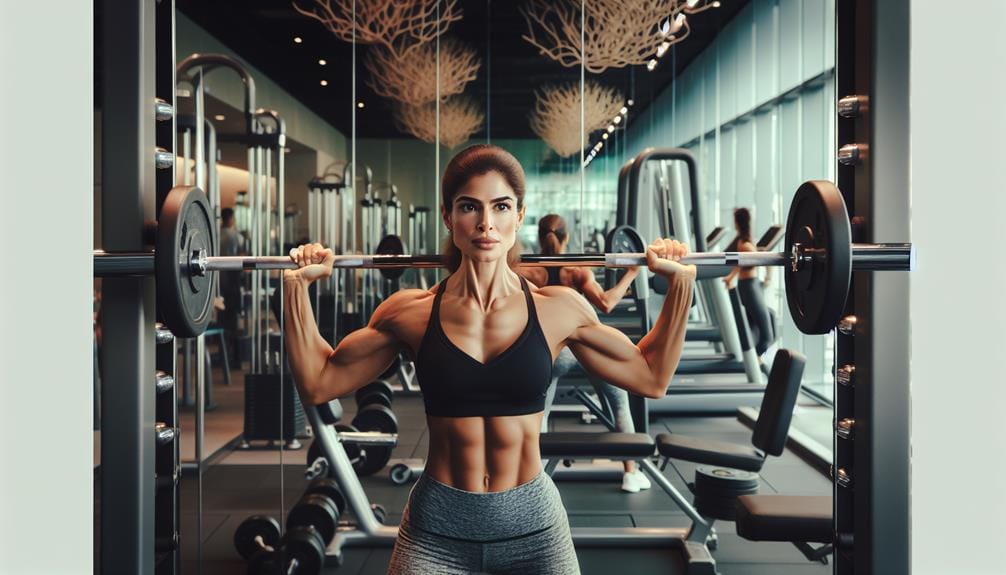
When you perform the overhead press, you primarily target your shoulders, triceps, and core muscles.
This powerhouse move in strength training improves shoulder strength and upper body stability.
And hey, who doesn't want shoulders that scream, “I lift things up and put them down”?
Reverse Fly
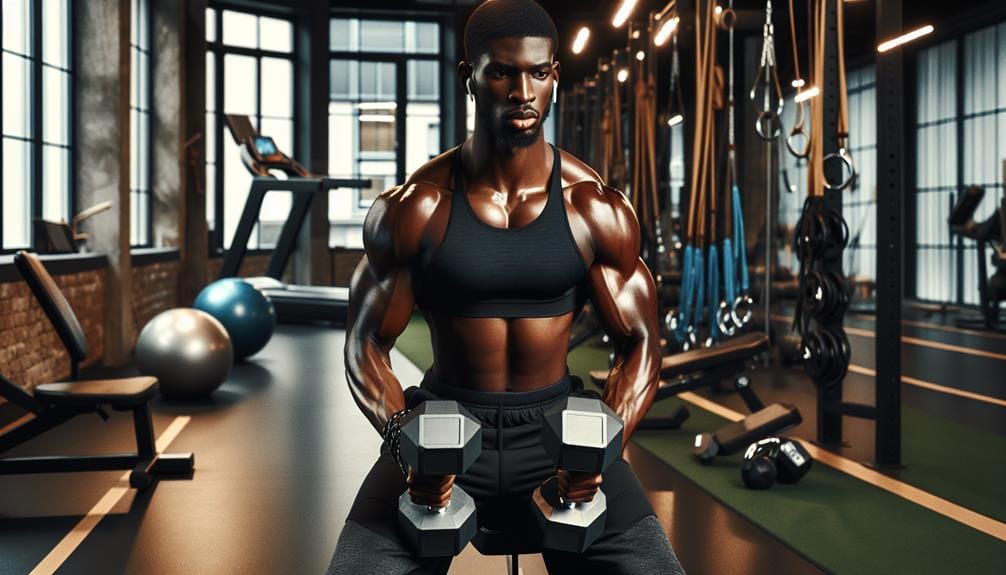
After mastering the overhead press, it's time to focus on the reverse fly to target your rear deltoids, mid-back, and upper traps. Picture this: you, with a pair of dumbbells, looking like a superhero ready to take flight. This exercise is fantastic for improving shoulder stability and enhancing your posture.
By incorporating reverse flys into your routine, you'll not only balance out those pressing movements but also give your upper body a more rounded and aesthetic look.
To perform the reverse fly, stand or sit with a slight bend at the hips, holding dumbbells. With a slight bend in your elbows, raise your arms out to the sides, squeezing your shoulder blades together. Voilà! You're now a posture-perfecting, shoulder-stabilizing machine.
Biceps Curls
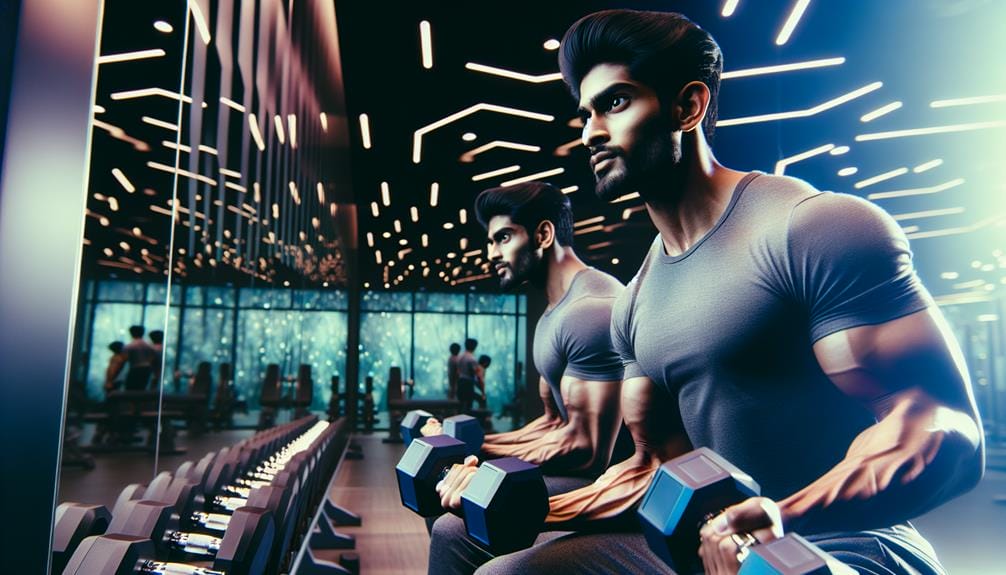
Biceps curls are a staple in any upper body workout, directly targeting the biceps and forearms for increased strength and definition. To master biceps curls, use proper form: keep your elbows close to your body and control the weight throughout the movement.
Don't let your arms flail around like inflatable tube men. Spice things up with different grips—try hammer or reverse grip to hit various bicep parts.
Triceps Kickbacks
Looking to tone and strengthen the back of your arms? Triceps kickbacks are your go-to move! This strength training exercise targets the triceps muscle group in your upper arms. By extending your arm behind your body with a dumbbell, you'll effectively engage and isolate those muscles. Keep your form on point to maximize results.
Here's a quick guide to get you started:
| Step | Action | Tip |
|---|---|---|
| 1 | Bend forward | Keep your back straight |
| 2 | Hold dumbbells | Elbows close to sides |
| 3 | Extend arms back | Squeeze triceps |
| 4 | Return to start | Control the motion |
Triceps kickbacks will not only enhance your arm definition but also boost your overall upper body strength.
Face Pulls
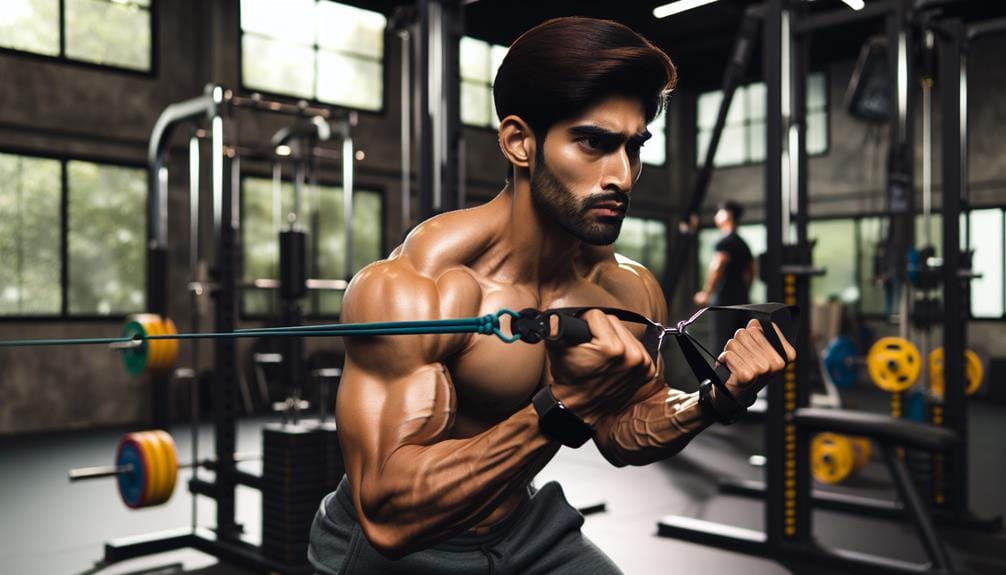
Face Pulls are essential for improving posture and shoulder health, targeting the rear deltoids, upper back, and traps.
Make sure to pull the rope or cable attachment towards your face at head level, focusing on maintaining proper form.
This exercise helps balance pushing movements in your routine and prevents shoulder injuries by strengthening stabilizing muscles.
Proper Face Pull Form
To master Face Pulls, make sure you pull the rope towards your face while keeping your elbows high. This technique boosts shoulder health, improves posture, and targets those underappreciated rear delts, upper back, and traps. Think of it as giving a high-five to your shoulder injuries—because they're about to be history!
Start by setting the rope attachment at upper chest level. Stand with feet shoulder-width apart, and grasp the rope with an overhand grip. As you pull, keep your elbows high and squeeze your shoulder blades together. Imagine you're trying to elbow someone behind you—gently, of course.
Done right, Face Pulls can seriously upgrade your upper body game, making you the superhero of shoulder health and posture!
Benefits for Posture
Incorporating face pulls into your routine can guarantee your posture by strengthening the muscles that keep your shoulders back and aligned. Think of it as giving your upper back a VIP treatment, targeting those rear delts and traps.
You'll strut around with the confidence of someone who's just found out pizza has no calories. Face pulls are the secret sauce for shoulder health, preventing shoulder injuries and imbalances. By focusing on your upper back, they keep you from hunching over like an overworked desk jockey.
Regular face pulls guarantee better alignment, making you stand tall and proud. So, get pulling and wave goodbye to those rounded shoulders and hello to superhero posture!
Dips
When you're looking to build serious upper body strength, dips are an essential exercise that targets your triceps, chest, and shoulders. You'll love how dips promote muscle development across multiple areas. You can perform them using parallel bars, a dip station, or even a sturdy chair at home.
Here's how to master dips:
- Form is King: Keep your body upright, elbows close, and lower until your upper arms are parallel to the ground.
- Get Creative: No fancy equipment? Use a chair or bench.
- Boost the Challenge: Add weight with a dip belt or hold a dumbbell between your legs.
- Compound Gains: Dips work multiple muscle groups simultaneously, making them super efficient.
Farmers Carry
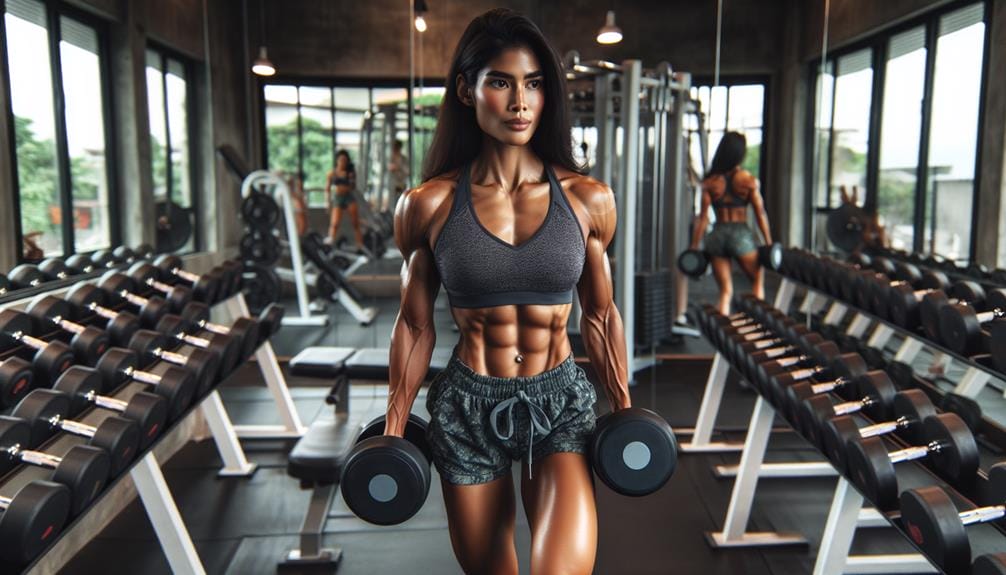
Farmers Carry transforms your upper body workout by combining strength and stability training in one powerful move. Imagine walking like a human forklift, holding heavy dumbbells or kettlebells in each hand. This exercise boosts upper body strength, particularly in your arms, shoulders, and traps.
Not only will you look like a superhero, but you'll also improve your core stability and posture, keeping you upright and proud. Farmers Carry can be done for distance or time, making it a versatile addition to your routine.
Plus, it sneaks in some cardio, so you're getting more bang for your buck. Incorporate this move and watch your upper body strength soar, one step at a time.
Pull-Ups
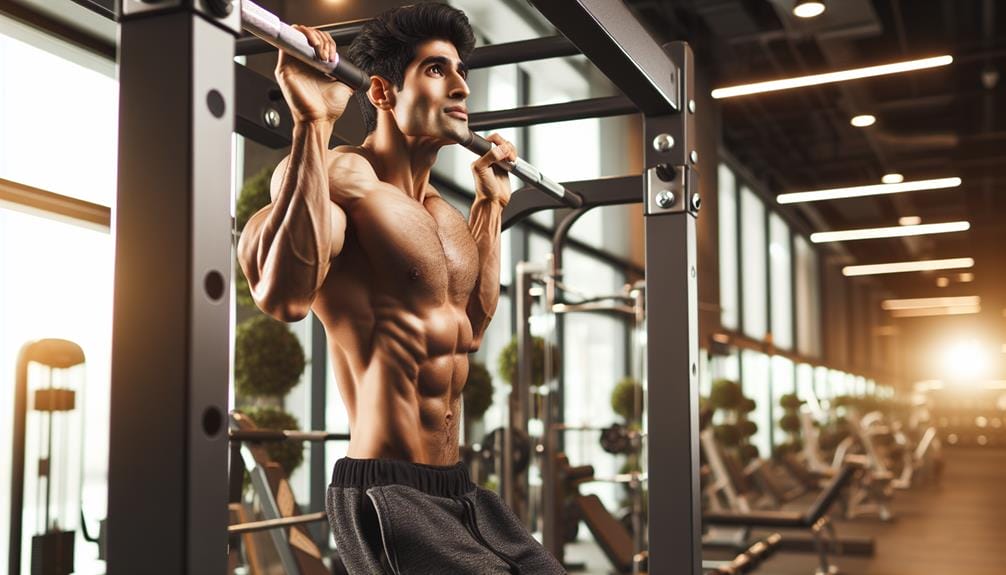
Pull-ups are a powerhouse exercise that can dramatically enhance your upper body strength and definition. They target your back, biceps, and forearms, making them a triple threat in your workout routine. Plus, they do wonders for your grip strength and upper body stability.
Imagine hanging on for dear life, but looking cool while doing it.
Here's why you should add pull-ups to your regimen:
- Back: Engage your lats for that coveted V-shape.
- Biceps: Say hello to bicep peaks without the endless curls.
- Forearms: Get a grip, literally, with improved forearm strength.
- Muscle definition: Sculpt those muscles for a more chiseled look.
Skull Crushers
When performing skull crushers, you'll want to focus on proper form to maximize benefits and avoid common mistakes. This exercise targets your triceps, helping to build strength and size with each controlled movement.
Proper Form Tips
To effectively target your triceps during skull crushers, keep your elbows stable and close to your head. This guarantees your upper arms stay stationary, maximizing muscle engagement. When lowering the weight toward your forehead, control the movement to avoid an unplanned visit to the ER. Remember, proper form is key!
Here's a quick rundown:
- Elbows: Keep them tucked in tight.
- Upper Arms: Stay still—no flapping allowed.
- Weight Control: Lower it smoothly; no sudden drops.
- Mind-Muscle Connection: Focus on your triceps doing the work.
Use a manageable weight to prevent injury and don't lock out your elbows at the top. Follow these tips, and you'll crush those skull crushers like a pro!
Benefits of Skull Crushers
Skull crushers offer a highly effective way to target and strengthen your triceps, enhancing both muscle definition and overall upper body strength. This triceps workout isolates those three-headed muscles, giving them a chance to shine and making your arms look fantastic.
When executed with proper form, skull crushers can prevent elbow strain and keep your joints happy, ensuring you're ready for more upper body strength training. Plus, the muscle development you gain from skull crushers can boost your performance in other exercises, like bench press and shoulder press.
Common Mistakes Avoidance
While skull crushers can greatly enhance your triceps, it's important to sidestep common mistakes to maximize benefits and prevent injuries.
Here's how:
- Avoid excessive weight: Don't go macho; too much weight strains your elbows and wrists.
- Keep upper arms stationary: Channel your inner statue and make sure your upper arms don't budge. This isolates your triceps effectively.
- Controlled movement: No flailing allowed! Move with purpose to engage your triceps fully.
- Avoid flaring elbows: Keep those elbows tucked in; flaring them out invites shoulder pain.
Additionally, maintain a neutral wrist position and stabilize grip on the weights to avoid wrist discomfort.
Follow these tips, and your triceps will thank you—without any unwanted drama!
Safety Tips
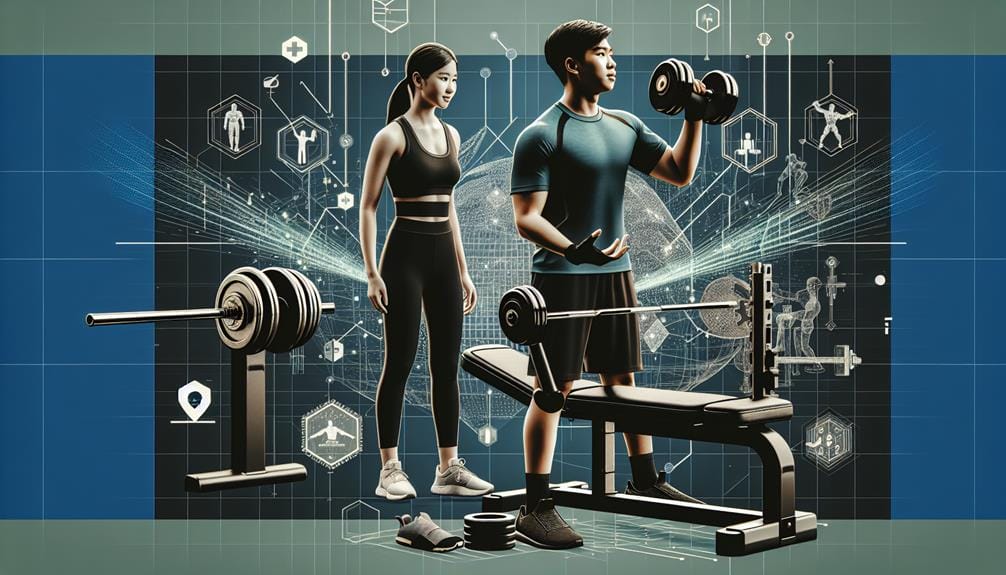
Before diving into your upper body workout, always prioritize safety to guarantee a productive and injury-free session. Start with a proper warm-up to get those muscles ready for action, enhancing your upper body strength and reducing injury risks.
Focus on maintaining good form and technique—nobody wants to be the person who pulls a muscle trying to impress the mirror. Don't forget to allow for rest and recovery; your muscles need downtime to grow stronger.
If you've got any medical concerns, a quick healthcare provider consultation can save you from turning a minor issue into a major catastrophe. Finally, listen to your body. If something feels off, it probably is—better safe than sorry!
Conclusion
In conclusion, this upper body workout plan will transform your arms, shoulders, and chest into pillars of strength, much like the mighty Atlas.
By combining exercises like barbell bench presses, push-ups, and pull-ups, you'll build a solid foundation.
Don't forget to include warm-up stretches and follow safety tips to prevent injuries.
Incorporate this plan consistently, and you'll see significant improvements in your upper body strength and overall fitness.
Stay committed, and your efforts will pay off.






Leave a Comment